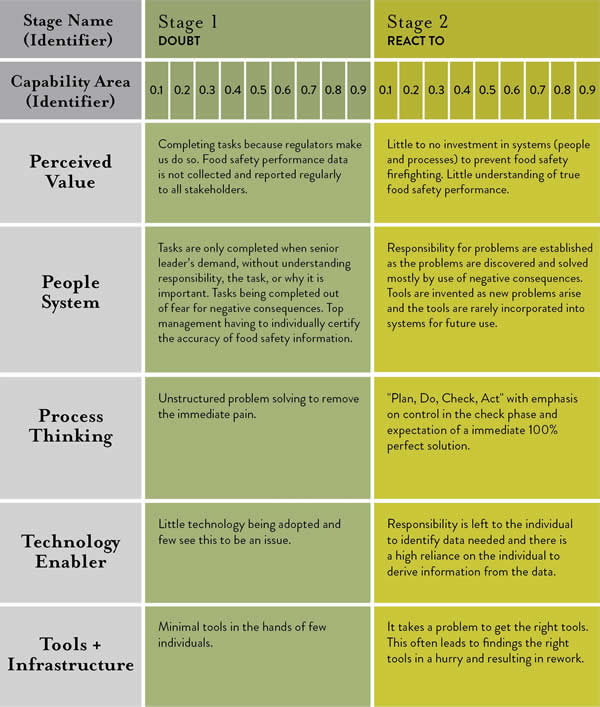After much anticipation, FDA has finally published the FSMA final rules. If you’ve had time to dig into the details, you most likely noted the new initiative that requires companies to measure food safety culture. The industry is also seeing SQF, BRC and other GFSI audit schemes ramping up discussions around measuring food safety culture. However, FDA and GFSI audits aside, how do you create a culture for sustained compliance with this initiative? Follow these 10 tips to ensure your food safety culture is constant and in line with the new requirements

1: Create a solid foundation of programs, procedures and policies
Have a preset annual schedule for review and update of all programs, procedures and policies. Don’t let the schedule slide because there are competing priorities. A small pebble is all it takes to start ripple effect in the company, making it difficult to recover.
2: Set clear expectations, driven from the top down
Everyone should follow the rules and guidelines—from visitors to the CEO to the plant manager to the hourly employee. A “no exceptions” policy will drive a culture that is sustainable and drive a “this-is-just-how-we-do-things” mindset.
3: Use record keeping to ensure that food safety culture is well documented and data-driven
Collect the data that is measureable and non-subjective to help drive continuous improvement. If you collect it, you must do something with it. Good documentation is imperative to proving you did what you said you were going to do, especially in the event of an audit. Be stringent in training, and review all documentation before it hits the file cabinet to ensure it is accurate and appropriate.
4: Implement a robust continuous improvement process
Forward momentum through a continuous improvement process cannot be achieved unless management nurtures the program. If you are not continuously improving, you are falling behind.
5: Have a 360-degree approach to employee engagement with 24/7 awareness and communication
Top-down communication is critical to highlighting the priorities and needs of an organization and will not be effective unless an organized program is in place. Organizations that are not making the necessary pivots to communicate with the multiple generations within their workplace today will struggle to sustain change.
6: Foster an atmosphere of mutual respect
Treat people as you would like to be treated, turn the other cheek, etc. There may be lots of adages you quote, but which one best describes your facility and the relationships with management and peers on a daily basis?
7: Be sure employees have consumer awareness for the products they produce
Do your employees know who the end consumer is of the product that they are producing every day? Does your culture include a review of consumer complaints and customer complaints with your frontline workers? Listening in to a call center is a very powerful way to help employees understand what affects consumers and how their job is critical to avoiding a food safety or quality issue.
8: Create accountability across the board
Hold folks who do not support the culture in which you are striving to develop or maintain accountable, regardless of their position or stature.
9: Provide positive reinforcement. It’s the best motivator
Work to catch people doing things right and make a big fuss when you do. Positive reinforcement for a job well done is the most powerful motivator. It helps keep every team member on board with food safety commitments.
10: Celebrate often
We spend too much time at work not to celebrate all the good things that are accomplished. Whether it’s a cake and recognition for those that served in the armed forces on Veterans Day or a successful launch of a new product—celebrations are a great way to recognize and reinforce your employees’ hard work. Identifying and correcting mistakes should also be celebrated; they are fertile ground for making changes and provide great nutrients for continuous improvement.










This is the first time I’ve seen food safety culture as a requirement of FSMA. There has been so much focus on Produce, FSVP and PC that perhaps this has been missed. Which rule would I find referencing Food Safety Culture and associated requirements.
There are rules Kristen and then there is how to comply with them.
I’ll tell you a story that might shed some light on culture and how it fits into the scope of things. In a conversation with warehouse manager I was told how an OSHA inspector (could be any number of agency auditors including FDA, but this was OSHA) on a visit went to the file cabinet where inspection forms were retained. He pulled out a form that was obviously ‘pencil whipped’ and asked if the employee who signed the form was at work. He was and the OSHA inspector went out and held up the form to the lift driver and asked “Did you fill out this form?” The reply: “Yes I did, but I didn’t inspect the forklift.” (results: $10,000 fine). OSHA does not require a culture, they require that the lift truck gets inspected by the driver before he takes it out to work with.
The ‘culture’ of compliance in that operation was one of ‘fill out the form’, it is required’. So they fill it out. However, because the FORM is completed does NOT mean the job was done or the truck was passed.
A culture of compliance is not mandated by any agency. It is defined as : a way of thinking, behaving, or working that exists in a place or organization (such as a business) (Merriam Webster). The correct culture in the example I gave is one of SAFETY and equipment condition. It is important to have the culture because it will be a safer place to work. A safer place to work means several things: 1) to the equipment user – I won’t get hurt, won’t lose time, won’t die from an equipment failure , 2) to the company it means lower workman’s comp, lower turnover, a healthier and safer environment which nets less lost time of experienced workers, 3) the agency sees validation in the documents that the culture exists, that the company takes the agencies’ rules to heart and complies with the meaning and spirit of the regulations put forth by the agency.
No Kristen, you do not have a requirement of food safety culture outlined by the agency. What Holly is pointing to is that if you do not have one, if you do not believe in it, you will at some point run afoul of the rules just like the warehouse manager above.
you won’t find a specific rule. “food safety culture” is the philosophy upon which FSMA is based – that food should be safe.
I think what is throwing me off and I’m trying to more deeply understand is the statement in paragraph #1: “you most likely noted the new initiative that requires companies to measure food safety culture”. I totally understand your comments and that was the thinking I had until reading this article which is telling me food safety culture measurements are somehow required.
I’m planning to operate my own food manufacturing business someday, that’s why I’ve also been thinking that maybe it’ll be best to hire a microbial testing service. I agree with you that collecting that is measurable would be beneficial for the said business. Also, what you stated is correct; continuous improvement is necessary because, without this, it means that the business is falling behind.